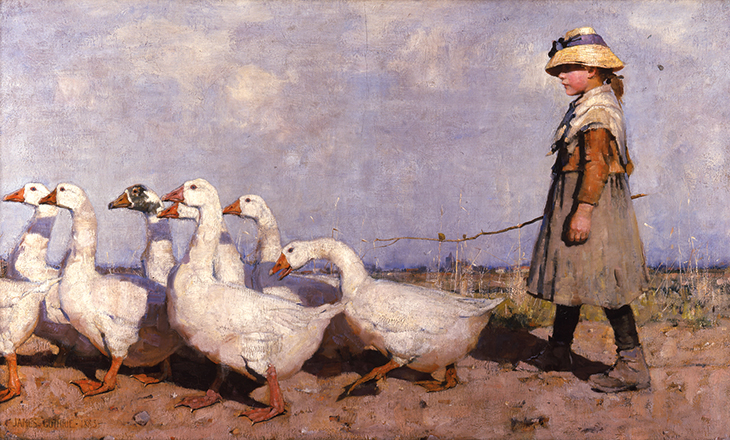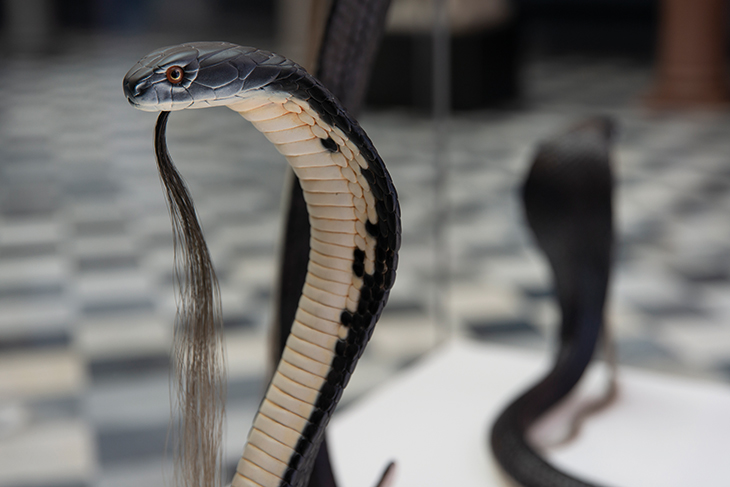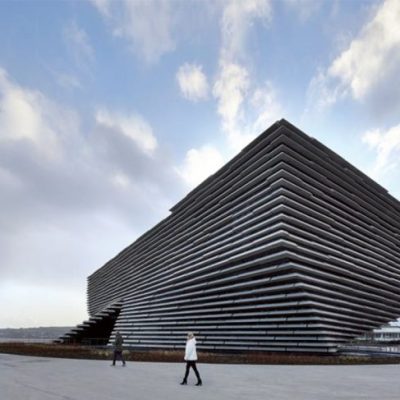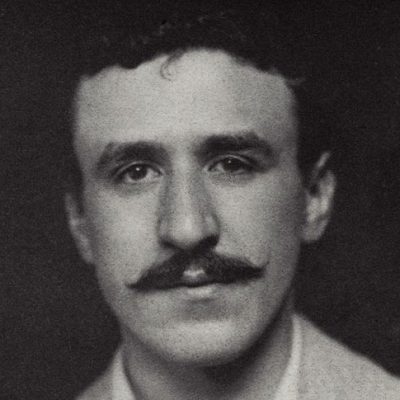‘Why did people make a fuss of pictures?’ wonders a character in Lewis Grassic Gibbon’s novel Grey Granite (1934). He has just ducked out of the rain that lashes against the ‘tumbling rigs of grey granite’ in the fictional town of Duncairn on the north-east coast of Scotland – a transparent substitute for Aberdeen – into the municipal art gallery. It is ‘dingy and desolate’; he takes a lonely pew opposite an unspecified Renaissance painting (‘couldn’t be bothered to find out the painter’), and begins to imagine the sorts of things that he would like to see here instead – ‘pictures of the poor folk since history began’, which might speak more directly to his own experiences of the city during that beleaguered decade. Before long, however, he gives up, and asks himself again: ‘Oh hell, what had it to do with you?’
I am looking down at the floor of Aberdeen Art Gallery, where a hyperreal bronze sculpture of a sleeping bag – Gavin Turk’s Habitat (2004) – appears to crumple before me, when I am suddenly put in mind of this scene. Not because anybody could today describe the place as ‘dingy and desolate’ – when I visit in late October, it is about to reopen after a four-year, £34.6m renovation and expansion. Rather, it is because the particular disaffection of Gibbon’s malcontent seems to be precisely what the team led by Christine Rew, in reimagining both the architecture of the museum and the city’s art collections, has had foremost in its sights. Turning towards me from the Turk sculpture, Rew smiles and says: ‘I think a lot of younger people really have been fooled over the years, thinking that somebody has left their sleeping bag here. It’s something people are so used to seeing in the streets, and so it’s a really interesting way into appreciating art. We want people to understand that art is for everybody.’
Openness and accessibility have been the guiding principles behind Hoskins Architects’ redesign of the building. I enter to find that the Italianate marble porticoes of the ground-floor sculpture court, designed in 1905 by local architect Alexander Marshall Mackenzie, are now bathed in daylight, which floods in both from above – through a great oval skylight in the copper-clad roof of the new second storey – and through the glass doors that now connect the courtyard, via Mackenzie’s Grecian facade of Aberdonian granite, to the street beyond. The court had previously been partitioned off from view of the street, but Rew tells me that ‘opening up the front range was really important to us. Because if you’re not used to visiting a gallery – if you don’t know how you’re supposed to read one – well, now you can stand out there in the street and see straight in. We wanted it to be as welcoming as possible.’
More difficult than getting people in, of course, is keeping them there – and making sure they keep coming back. Rew has been in charge since 2004, and for all that time there has only been space for around 370 works from the permanent collection to be displayed at any one point. The hangs changed rarely, and erred on the side of the traditional: a room devoted to the French Impressionists here; there a room stacked high with overcrowded display cases, in which the gallery’s decorative-arts collections were stifled. But with the addition of another storey, as well as an off-site storage facility that opened in 2016, there are now eight new gallery spaces, and a total of more than 1,000 works on show. The project has not been without its challenges – to the perhaps inevitable grumbles over cost and building delays one can add objections, from some quarters, to the aesthetics of the roof addition, and in particular to the removal of the marble-veneered staircase, making way for a street-level foyer. But as local councillor Marie Boulton has pointed out, ‘this is probably the biggest capital investment in culture’ that the town, with its population a shade under 200,000, ‘will ever see’. The result is that, for the first time, the story of Aberdeen’s art collections can meaningfully be told.
That story begins in 1873, when the wealthy Aberdeen flour miller John Forbes White organised a public exhibition of paintings, sculptures and decorative arts, drawn from private collections in the region. He was spurred to do so in part by civic rivalry; Aberdeen had grown prosperous from the granite trade, and yet, not having its own art gallery, White felt it ‘had been completely discredited […] by Dundee’, since its neighbour had opened the Albert Institute (now the McManus) as early as 1867. White’s exhibition, which took place in the grand environs of the city’s neo-gothic Town and County Hall, was hailed in the local press as a show of ‘art for all’. Within a few years – with the help in particular of the local granite merchant Alexander Macdonald and the painter George Reid – an Art Gallery and Industrial Museum Committee of Management had been established. By 1885, the first phase of the new building by Mackenzie was complete – Mackenzie, the leading architect of his day, also designed the facade of the magisterial Marischal College building nearby, which, as any Aberdonian you meet will tell you, is the second-largest building of granite in the world.
In some ways, White, Macdonald and Reid were chips off the old block; industrious Scots who believed it their civic duty to establish a gallery for the ‘betterment’ of their fellow citizens. ‘They wanted to educate the masses,’ Rew says wryly. However, from the very earliest stages in planning for the new gallery, as well as in their own collecting, they prioritised the work of contemporary artists. On this point Macdonald, in particular, was adamant; when he died in 1884, he bequeathed his collections of paintings to the as-yet-unbuilt gallery, writing in his will: ‘I may note that I purchased all my pictures direct from the artists’ – and the works on show reveal how his tastes changed by virtue of his association with painters. In the first room of the museum, beyond the sculpture court, is a wall of small oval portraits of identical format – around 40 of some 90 commissioned by Macdonald from c. 1880, and after his death by his wife, Hope, constituting a kind of personalised Who’s Who of Victorian artists. In some places, it reads like a Royal Academy yearbook – here are self-portraits by William Powell Frith, Lawrence Alma-Tadema, Frederic Leighton, and George Frederic Watts. Yet there are also self-portraits by Jules Breton and Jozef Israëls, revealing that Macdonald was looking past the academicians. In line with the contemporary crop of Scottish painters, in particular the Glasgow Boys, he was looking to the realist currents that were flowing out of France and the Netherlands.
To Pastures New (1883), James Guthrie. Aberdeen Art Gallery & Museums

One of the gallery’s most widely cherished Glasgow Boys works appears in this same room: James Guthrie’s To Pastures New (1883), which for the lightness of its palette and the sentimental clarity of its vision is a high point of the movement; unable to buy it himself, White persuaded the elderly advocate Francis Edmond to purchase it for the city. Alongside it are works that have been collected throughout the intervening century and more since the gallery’s inception – from J.W. Waterhouse’s Penelope and the Suitors (1912) to a portrait bust of Francis Bacon by Clive Barker (1978). Sir James Murray, chairman of the gallery’s board, purchased the Waterhouse directly from the artist in 1912, the year of its completion, stoking up considerable controversy as to whether the lavish work was an appropriate use of public funds; the Barker, bought in 1978, was likewise denounced by the city councillors, this time simply for being ‘grotesque’. In opening its new displays with this abridged history of how the city’s art collections have developed, the gallery reveals that the essential quality of Macdonald’s legacy lies not so much in his taste but in his championing of the new. In effect, the terms in which he couched his will have governed the way the gallery has seen itself ever since. He stipulated that his bequest could not be used to purchase any work of art that was more than 25 years old. ‘What that means,’ Rew tells me, ‘is that we now have 130 years’ worth of contemporary art in the collection.’ But Rew is also careful to point out that the gallery has ‘never been too worried about filling gaps’. Her own role – both in overseeing the redevelopment, and in spearheading acquisitions – has been ‘about making sense of the collections we already have, and taking them in new directions.’
Part of Macdonald’s legacy has been the continued purchase of works from artists at early stages in their careers, as is evident from a first tour of the sculpture court. Here are plaster casts of works by Donatello and Raphael, first installed here with great fanfare in 1905, on the opening of the first of a series of extensions to the gallery. There is also Barbara Hepworth’s Requiem (1957), and next to it a Tracey Emin neon, For You (2008). But to the righthand side of the court is something far more surprising; a group of three cobras, made out of painted jesmonite with glass eyes and human hair, raise themselves up in a glass vitrine. This is The August Snakes Stand Erect (As That is How Their Beards May Be Best Admired) (2007) – the snakes are deities on Charles Avery’s fictional island Onomatopeia, from his epic project The Islanders (2004–). It is lovely to see such a prominent place given to early work by a Scottish artist in a public collection – a trick repeated in other galleries, with portraits by the ‘New Glasgow Boys’ Peter Howson and Adrian Wiszniewski, the latter of whom I’ve never seen so prominently displayed outside a commercial setting.
The August Snakes Stand Erect (As That Is How Their Beards May Best Be Admired) (detail; 2007), Charles Avery. Aberdeen Art Gallery & Museums

One of Rew’s missions since she arrived at the gallery has been to bolster the collections of silverwork. Rew tells me that, in 2006, she commissioned the metalworker Chris Knight to construct a silver coffee pot inspired by a coffee pot of c. 1760 by Coline Allan of Aberdeen. ‘I wanted to show a continuation,’ Rew says, ‘between the 18th century, when Aberdeen was one of the major centres for silversmithing in the UK, and the contemporary moment. And it’s also nice to give contemporary metalworkers the validation of seeing their work in a museum collection.’
Coffee pot (c. 1760), Coline Allan of Aberdeen. Aberdeen Art Gallery & Museums

Of course, in a municipal gallery, collections are built by chance as much as by design, accrued over the years through haphazard bequests and donations. One of the most impressive aspects of the new layout is how the curators have organised an uneven collection to create displays that, while on the face of it conforming to quite ordinary classifications of genre or historical moment, allow both for coherence and for surprising connections. Following Macdonald’s predilection for portraiture, one of the upstairs galleries has been given over to the genre. Here, one of Macdonald’s most cherished purchases – John Everett Millais’s The Convalescent (1875) – is shown near a rare work by Scotland’s first esteemed portrait-painter, George Jamesone (1589/90–1644), and a Francis Bacon study of Pope Innocent X. There are rooms dedicated to the sea, reflecting Aberdeen’s maritime economy, with works by William McTaggart and Joan Eardley; to abstraction, in which a rarely displayed painting by Bridget Riley is hung with paintings by Patrick Heron, William Dyce, and a host of others; and to the world wars and their aftermath, in which an old favourite among visitors – Eric Ravilious’s Train Landscape (1940) – is shown alongside two other works by Ravilious that have not previously been on display.
Throughout, the story of art that is represented here is resolutely both local and international – and it is in this sense that it captures the spirit of its founding members most aptly. The Aberdeen-born, self-taught etcher James McBey, whose entire archive, along with the majority of works in his studio, was presented to the gallery by his wife Marguerite shortly after his death in 1959, seems to typify this approach; the new room devoted to his work progresses through his wartime etching to his various travels through Morocco. In another room dedicated to the ‘Balmoral Phenomenon’ – the British monarchy’s love affair with Aberdeenshire during the Victorian period – a masterpiece by Edwin Landseer, Flood in the Highlands (1860), is shown alongside works by the somewhat younger Aberdeen-based artists John Phillip and Joseph Farquharson; Phillip’s Baptism in Scotland (1850), acquired with support from the Art Fund in 1984, at once complements the Romantic vision of Landseer and, with its subtle allusions to the Jacobite Rebellion, subverts it. Most impressive of all is the room dedicated to ‘French Impressions’, in which domestic scenes by Jules Bastien-Lepage and Alexander Mackenzie progress to a series of comparisons between the Impressionists, Post-Impressionists and Scottish Colourists that ought to be both the envy and the aspiration of other public galleries in Scotland. Cadell vies with Bonnard; George Leslie Hunter with Sisley; Peploe with Guillaumin.
‘For us as curators,’ says Rew, ‘the process of being closed for so long has been exciting – it has made us rethink. We have realised that there have to be several approaches to how we interpret.’ The variety of displays in the new gallery are expressly designed to offer something for everyone in the city – but the fact that they are united in combining local stories with an international history of art is what enables the new gallery to realise the hopes of its founders, in showing that art can speak to us all.
From the December 2019 issue of Apollo. Preview and subscribe here.


